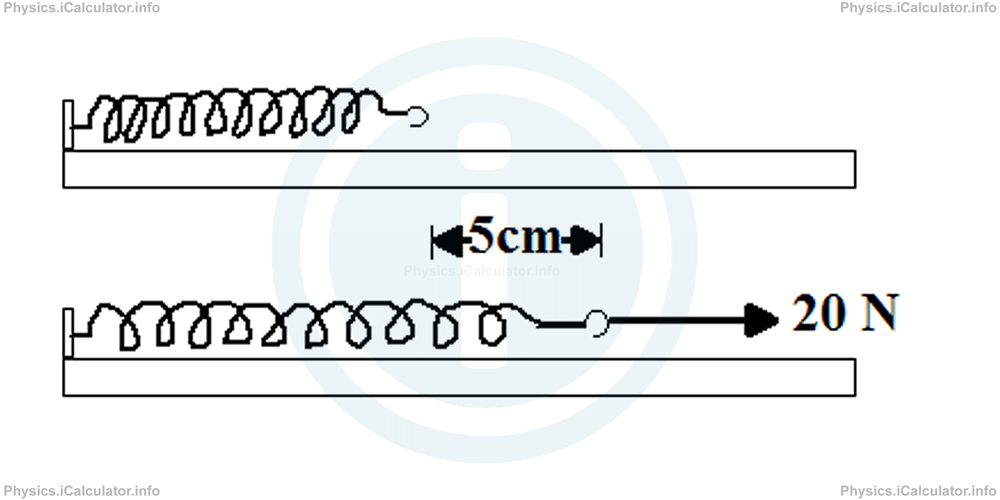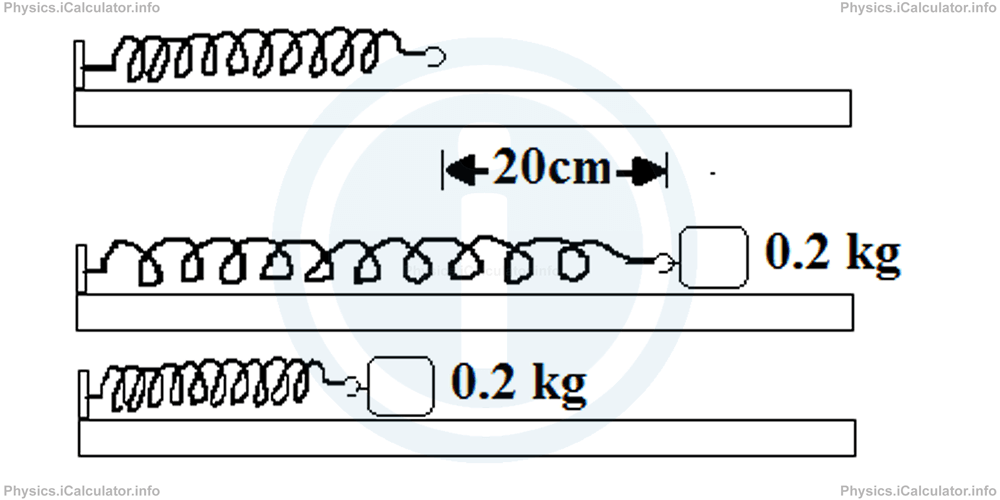Menu
Physics Lesson 10.1.6 - SHM in Elastic Springs
Please provide a rating, it takes seconds and helps us to keep this resource free for all to use
Welcome to our Physics lesson on SHM in Elastic Springs, this is the sixth lesson of our suite of physics lessons covering the topic of Simple Harmonic Motion, you can find links to the other lessons within this tutorial and access additional physics learning resources below this lesson.
SHM in Elastic Springs
Since the restoring force F is in the opposite direction to the acceleration a, we obtain from Newton's Second Law of Motion for the acting forces in springs:
= -k × x
where m is the mass of hanged object and k is the spring constant. Thus,
m × ω2 = k
Hence,
Or
Then we can substitute this value of angular frequency in the sine equation of SHM if oscillations are caused by an object hanged on an elastic spring.
Example 1
A spring is mounted in a horizontal plane with one end as stationary. A 20 N force exerted on this spring, causes an elongation of 5 cm as shown in the figure below.

Then, we stop pulling the spring, release it and attach a 0.2 kg object at the hook. Then we pull the spring by 20 cm and release it. As a result, the spring starts oscillate in SHM as shown below.

Calculate the following quantities.
- The spring constant
- The maximum and minimum velocities of the object
- The maximum and minimum acceleration
- The magnitude of velocity and acceleration when the object has moved halfway to the centre from its original position
Solution 1
a Spring constant is calculated by considering the initial pulling force F and applying the Hooke's law F = k × x. Thus, since F = 20 N and x1 = 5 cm = 0.05 m, we have
k = F/x1 = 20 N/0.05 m= 400 N/m
b The maximum velocity vmax is obtained by the equation
where
and
is the angular frequency.
This maximum velocity is at the equilibrium position, while the minimum velocity occurs at the maximum elongation or compression of the spring, where the object stops and makes ready to turn back. Hence, vmin = 0.
c From the equation
we obtain for the maximum acceleration amax:
= -(√k/m)2 × x0
= -k/m × x0
Considering only the magnitude of acceleration (i.e. not considering the negative sign), we obtain
= 400 N/m/0.2 kg× 0.20 m
= 400 m/s2
Again, the minimum acceleration occurs at the turning positions where the object stops, i.e. amin = 0.
d) Velocity and acceleration at a given instant are calculated through the sine or cosine functions adapted for SHM as discussed earlier in the theory.
Thus, since
where φ = π/2 because the object is initially at the maximum position which means it is shifted by one quarter of a complete cycle (the cycle starts from the equilibrium position, i.e. at middle of trajectory),
we have for the velocity v at any instant t:
We have
Thus, substituting the known values in the equation of velocity for this SHM, we obtain
= 8.94 × cos(44.7 × t + 3.14/2)
= 8.94 × cos(44.7 × t + 1.57)
and for acceleration a at any instant t:
= -0.20 × (44.7)2 × sin(44.7 × t + π/2)
= -400 × sin(44.7 × t + 1.57)
Now, let's find the time t in which the object is at halfway to the centre from the original position. But before, we must calculate the period T. Thus,
= 2 × 3.14/44.7
= 0.14 s
From the initial position to halfway to the centre, the object has moved by 1/8 of a complete cycle. Hence,
Thus, for t = 0.0175 s, we obtain
= 8.94 × cos(44.7 × 0.0175 + 1.57)
= 8.94 × cos2.35225 = 8.94 × (-0.70)
= - 6.258 m/s
We need only the magnitude of velocity, so v = 6.258 m/s.
Also,
= -400 × (-0.71)
= 284 m/s2
You have reached the end of Physics lesson 10.1.6 SHM in Elastic Springs. There are 6 lessons in this physics tutorial covering Simple Harmonic Motion, you can access all the lessons from this tutorial below.
More Simple Harmonic Motion Lessons and Learning Resources
Whats next?
Enjoy the "SHM in Elastic Springs" physics lesson? People who liked the "Simple Harmonic Motion lesson found the following resources useful:
- Elastic Springs Feedback. Helps other - Leave a rating for this elastic springs (see below)
- Oscillations Physics tutorial: Simple Harmonic Motion. Read the Simple Harmonic Motion physics tutorial and build your physics knowledge of Oscillations
- Oscillations Revision Notes: Simple Harmonic Motion. Print the notes so you can revise the key points covered in the physics tutorial for Simple Harmonic Motion
- Oscillations Practice Questions: Simple Harmonic Motion. Test and improve your knowledge of Simple Harmonic Motion with example questins and answers
- Check your calculations for Oscillations questions with our excellent Oscillations calculators which contain full equations and calculations clearly displayed line by line. See the Oscillations Calculators by iCalculator™ below.
- Continuing learning oscillations - read our next physics tutorial: Pendulums. Energy in Simple Harmonic Motion
Help others Learning Physics just like you
Please provide a rating, it takes seconds and helps us to keep this resource free for all to use
We hope you found this Physics lesson "Simple Harmonic Motion" useful. If you did it would be great if you could spare the time to rate this physics lesson (simply click on the number of stars that match your assessment of this physics learning aide) and/or share on social media, this helps us identify popular tutorials and calculators and expand our free learning resources to support our users around the world have free access to expand their knowledge of physics and other disciplines.